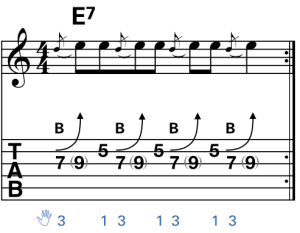
Techniques for the lead guitarist
Have you ever dutifully practiced your scales, as shown to you by a guitar teacher or in a book and wondered what is needed to turn it into real music? Vibrato and bending are two great techniques that will help to bring your guitar playing alive. Think of any accomplished lead guitarist - all of them would use vibrato and bending at some stage, to breathe life and expression into their playing. Let's have a look at how you can do this too.
What is Vibrato?
Vibrato is a technique of rapidly moving a note up and down in the direction of the adjacent strings. Vibrato is an important method of sustaining a note once it has been picked. It also gives much more expression to your playing. Vibrato is usually found on long notes, or a note at the end of a phrase. Vibrato is usually obtained by the movement of the wrist away from the neck and back towards the neck, much like turning a doorknob. The symbol for vibrato is a wavy line. Try playing this yourself.


Bending Notes
Bending notes is one of the classic sounds of lead guitar. Players such as B.B. King, Buddy Guy, Albert King, Stevie Ray Vaughan, Gary Moore, Joe Satriani, Paul Gilbert and Yngwie Malmsteen are all great note benders. Bending helps to add emotion and intensity to the music as well as giving your playing a more vocal-like quality. A bend is achieved by fretting a note and then pushing the string sideways across the fretboard towards the adjacent strings. One important point with bending notes is to use a supporting finger behind the finger you are using to make the bend. This gives you more strength and better control. When bending notes, it is also helpful to have the thumb of the left hand right up over the edge of the neck to help push back against the pressure of the fingers. The symbol for a bend is a curved arrow accompanied by the symbol "B". Try the following bend:



Here is an exercise for developing your ability to bend notes. Make sure you reach the exact pitch you are trying to bend to. In this exercise you are bending from D to E on the third string and then playing another E on the second string. Listen carefully to make sure your bent E note is not sharp or flat. Try recording yourself bending some notes and then listen back to check the pitch of your bends.


The following lick demonstrates the use of vibrato and bending. Give this a try:

Here is the audio recording, so you can hear how it sounds: To conclude this blog, try playing the following lick, based upon the C blues scale. Try altering the vibrato as well - making it stronger can inject even more life into your playing. Keep practicing to develop a good ear and feel for these techniques.

Here is the audio recording, so you can hear how it sounds:
We hope you've enjoyed this introduction to vibrato and bending. If you are keen to delve further into this and learn some great guitar licks, have a look at the Complete Blues Guitar Manual .











